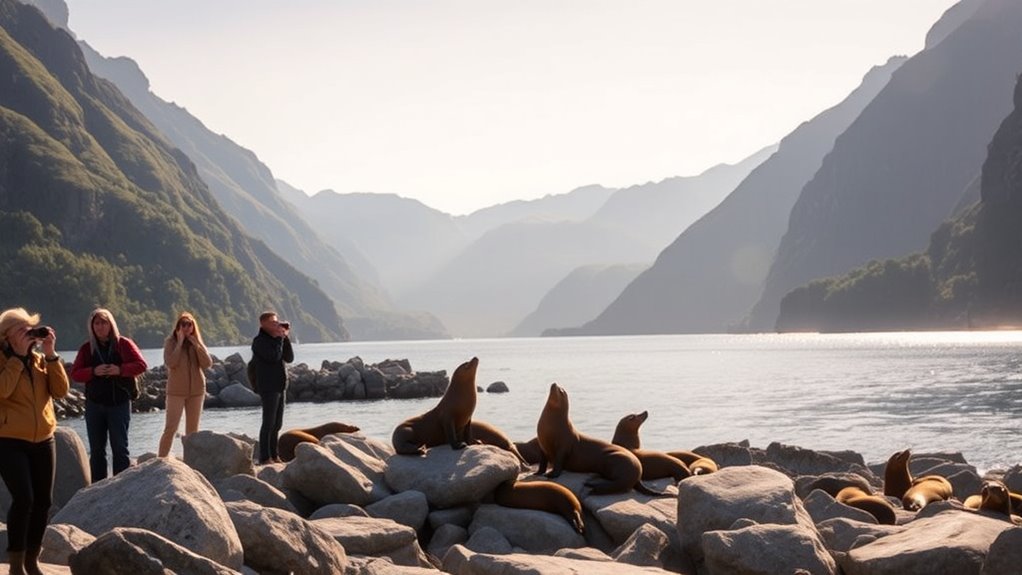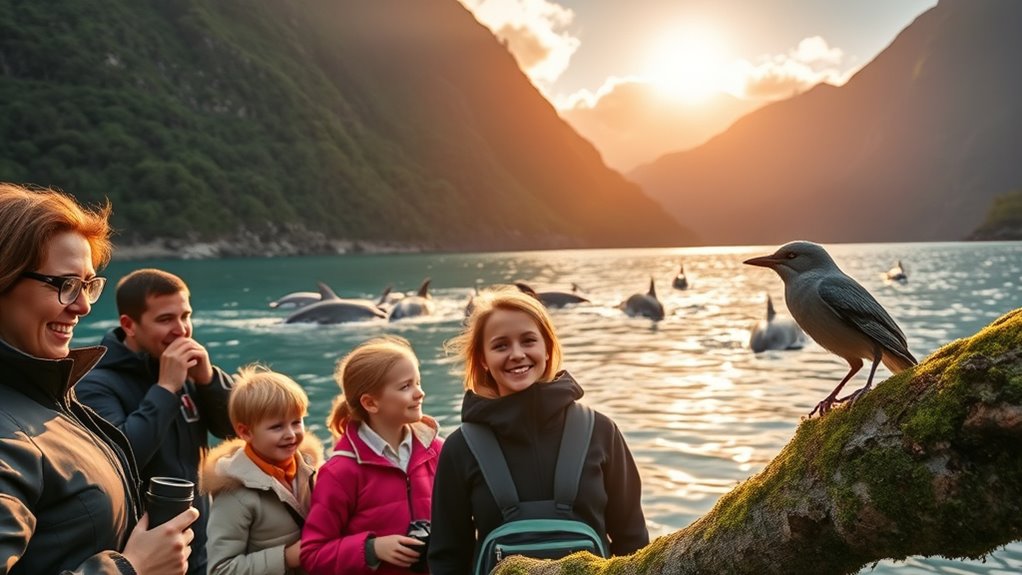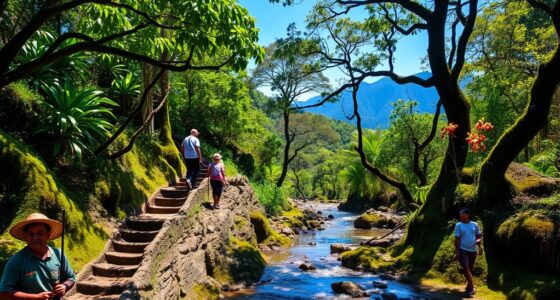When viewing wildlife in Fiordland National Park, always maintain a safe distance to respect their natural behaviors. Use binoculars or zoom lenses to observe without disturbing them, and keep noise levels low to avoid scaring them. Never approach or feed animals, as this can lead to harmful dependency. Remember to clean up after yourself to protect the environment. Following these guidelines guarantees a respectful and enjoyable experience in this beautiful ecosystem. There’s much more to discover about this responsibility!
Key Takeaways
- Maintain a safe distance from wildlife to avoid causing stress and disruption to their natural behavior.
- Use binoculars and zoom lenses for observing and photographing animals without getting too close.
- Keep noise levels low to respect and not startle birds and other wildlife during your visit.
- Always clean up trash and minimize environmental impact to help preserve the park’s natural beauty.
- Be patient and observant, allowing wildlife to behave naturally instead of forcing interactions for photographs.

When you explore Fiordland National Park, maintaining respect for the wildlife that calls this stunning place home is vital. The park’s diverse ecosystems support a rich variety of species, from the iconic kea to the elusive kiwi. To truly appreciate this natural wonder, you’ll want to follow some etiquette guidelines that guarantee both your enjoyment and the safety of the wildlife.
Exploring Fiordland National Park requires respect for its diverse wildlife and adherence to essential etiquette for a safe, enjoyable experience.
If you’re keen on bird watching, you’ll find Fiordland to be a paradise. The park boasts numerous vantage points where you can observe birds in their natural habitats. To enhance your experience, consider using binoculars; they’ll help you catch the intricate details of each bird without disturbing them. When you spot a bird, whether it’s a rare species or a common one, keep your distance. Remember, approaching too closely can stress the animals and might even disrupt their natural behaviors.
When photographing wildlife, it’s important to do so thoughtfully. Use a zoom lens to capture stunning images without encroaching on the creatures’ space. This not only keeps the animals safe but also allows you to take that perfect shot. Before snapping away, take a moment to observe how the animal behaves. If it seems agitated or tries to move away, it’s a sign to back off. You wouldn’t want to scare it off, and the last thing you want is to disturb its natural routine.
Moreover, avoid feeding wildlife. While it might be tempting to share your snacks with the local birds, this can lead to dependency and alter their natural foraging instincts. Instead, allow them to thrive in their environment without human interference.
Practice quietness while enjoying the sights and sounds of nature. Loud noises can startle wildlife and disrupt their activities. By being mindful of your surroundings, you’ll have a better chance of spotting elusive creatures and experiencing the park’s tranquility.
Finally, always clean up after yourself. Leaving no trace is essential in preserving the beauty of Fiordland. Whether it’s a wrapper from your lunch or a discarded water bottle, ensure you take everything back with you. Additionally, understanding the importance of wildlife conservation in such delicate ecosystems helps foster a deeper respect for nature.
Frequently Asked Questions
What Wildlife Species Can I Expect to See in Fiordland?
In Fiordland, you can expect to see a variety of wildlife. Look out for unique bird species like the kea, tui, and the rare Fiordland penguin. If you venture near the water, you might spot marine mammals such as dolphins and seals. Keep your eyes peeled for the majestic Fiordland crested penguin, especially during the breeding season. Each encounter offers a chance to appreciate the stunning biodiversity this area has to offer.
Are There Any Restrictions on Feeding Wildlife in the Park?
Like a painter with a blank canvas, you’ve got to respect the natural order when you’re in the park. There are strict restrictions against feeding wildlife, and for good reason. It disrupts their natural behaviors and can lead to dangerous situations for both animals and visitors. So, while it’s tempting to share a snack, remember to admire these creatures from a distance and let them thrive in their natural habitat.
What Time of Year Is Best for Wildlife Viewing in Fiordland?
The best time for wildlife viewing in Fiordland is during the spring and summer months, from September to March. This period coincides with seasonal migration and bird breeding seasons, when you’ll see many species actively nesting and raising their young. You’ll spot everything from dolphins to various birds, making it an ideal time for your wildlife adventures. Just remember to keep your distance and respect their natural habitats while enjoying the sights!
Can I Bring My Pet While Visiting Fiordland National Park?
You can’t bring your pet while visiting Fiordland National Park due to strict pet restrictions. These rules are in place to ensure the safety of both your animal and the native wildlife. Pets can disturb local ecosystems and pose risks to vulnerable species. If you’re planning to visit, it’s best to make arrangements for your pet elsewhere, allowing you to enjoy the stunning landscapes without compromising animal safety.
Are There Guided Tours Available for Wildlife Viewing?
If you’re enthusiastic to explore the wonders of nature, guided tours are your golden ticket. You’ll find numerous options led by wildlife experts who’ll share their knowledge and enhance your experience. These tours often take you to the best spots for wildlife viewing, ensuring you don’t miss a thing. So, gather your sense of adventure, and let the experts lead you into the heart of Fiordland’s breathtaking wilderness!
Conclusion
When you venture into Fiordland National Park, remember to tread softly and show respect for the wild inhabitants. By giving them space and observing from a distance, you’re not just witnessing nature’s beauty; you’re allowing its delicate balance to thrive. Think of it as a gentle dance, where you’re the quiet observer, letting the wildlife be the stars of the show. So, enjoy the wonders around you, and leave no trace of your presence behind.










